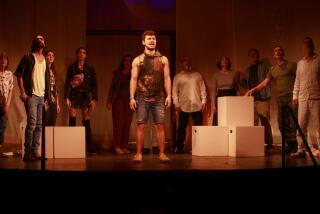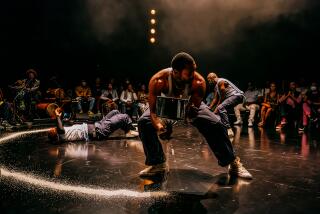Well-Worn Soles
It’s 1936, in rural Ireland. Five sisters--unmarried and struggling to make ends meet--are attending to household chores when their unreliable radio crackles to life and a folk song throbs insistently through the air. One sister, her hands covered with flour, smears a primitive mask onto her face, lets out a whoop and begins stomping. One by one, her siblings join her in a floorboard-pounding frenzy of dance--giving themselves over to pleasure, letting their cares slip away.
As wonderfully crafted as the words are in Brian Friel’s “Dancing at Lughnasa,” it is this nonverbal sequence that speaks most eloquently. Director Jessica Kubzansky and her performers get it gloriously right in a production that is part of McCoy Rigby Entertainment’s professional season at the La Mirada Theatre. They poignantly illustrate the heart’s need to leap free and demonstrate, in the process, how those thundering folk steps in “Riverdance” and “Lord of the Dance” have sprung from Irish life.
“Dancing at Lughnasa” premiered in 1990 and quickly accumulated a slew of awards, making it yet another triumph for the Irish author of “Faith Healer,” “Translations” and the recent “Molly Sweeney.”
The story is narrated by Michael, the youngest sister’s illegitimate son. As he returns for a look at the abandoned family home, his thoughts return to the autumn he was 7--the golden, shrinking days before his family slipped into a long dark winter of the soul.
The events of that fall were driven by the contagious spirit of Lughnasa, a harvest festival marked by ecstatic celebrations. Dancing is a key part of the festivities, and Friel makes it his central motif. Whether it’s a raucous eruption among sisters or a dreamy spin in a lover’s arms, dance enables these characters to transcend their humdrum lives, implanting a memory of absolute joy that sustains--and taunts--them once the music ends.
Jamison Jones brings playfulness, compassion and a nicely understated sense of loss to the role of the adult Michael. As his 26-year-old mother, Chris, in the flashback, Michelle Duffy conveys a delicate loveliness about to be turned hard and brittle. She’s already looking haggard, and sharpness is creeping into her voice.
As Maggie, the second-oldest sister and family jokester, Cynthia Mace is at once gritty and lighthearted. She knows she’s been dealt a bad hand, but she has decided to laugh at fate rather than be defeated by it. And Jefrey Alan Chandler is befuddled yet quietly resilient as Jack, the oldest sibling, a longtime missionary priest who has been sent home from Africa in disgrace.
Costumer Zoe DuFour dresses the family in drab, humble work clothes yet adds little details--a touch of lace at the collar, for instance--to indicate that the sisters handmade these garments with love. Set designer John Iacovelli delivers a simple, sturdy stone house that is surrounded by a wild, overgrown yard and humbled beneath a dazzling blue sky.
A couple of performances fall short, and an electronic hum provided distracting accompaniment to Saturday’s opening performance. But Kubzansky and choreographer Kay Cole have infused this production with vigor and grace--and make it dance, dance, dance.
BE THERE
“Dancing at Lughnasa,” La Mirada Theatre, 14900 La Mirada Blvd. Tuesday-Saturday, 8 p.m.; Sunday, 7:30 p.m.; Also Saturday-Sunday, 2:30 p.m. Ends May 10. (562) 944-9801 or (714) 994-6310. $33. Running time: 2 hours, 21 minutes.
More to Read
The biggest entertainment stories
Get our big stories about Hollywood, film, television, music, arts, culture and more right in your inbox as soon as they publish.
You may occasionally receive promotional content from the Los Angeles Times.











